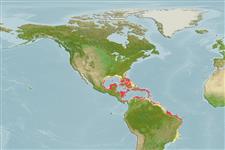Environment: milieu / climate zone / depth range / distribution range
Écologie
marin récifal; profondeur 20 - 60 m (Ref. 5217). Tropical; 33°N - 33°S, 99°W - 30°W
Western Atlantic: Florida Keys (USA), Bermuda, and Bahamas to Brazil. Found throughout the West Indies; absent in Colombia (Ref. 3798).
Length at first maturity / Taille / Poids / Âge
Maturity: Lm 30.5, range 30 - ? cm
Max length : 79.0 cm TL mâle / non sexé; (Ref. 40637); common length : 50.0 cm TL mâle / non sexé; (Ref. 5217); poids max. publié: 7.1 kg (Ref. 40637)
Épines dorsales (Total): 12; Rayons mous dorsaux (Total): 15-17; Épines anales 3; Rayons mous anaux: 7 - 8. Scale rows immediately below lateral line oblique (Ref. 26938). Usual color phase dull silvery, the fins largely gray; no black pigment below upper margin of preopercle; the dorsal and caudal fins of subadults and the back above a line from dorsal base to lower margin of caudal fin are often blackish (Ref. 13442).
Inhabits seagrass beds, sand flats, coral reefs, and wrecks (Ref. 9710). Found in pairs or larger schools (Ref. 3798). Feeds on benthic invertebrates (Ref. 3798). Has been observed to nose into the sand to eat such subsurface invertebrates as peanut worms and heart urchins (Ref. 13442). Marketed fresh (Ref. 3798).
Oviparous, distinct pairing during breeding (Ref. 205).
Cervigón, F., 1993. Los peces marinos de Venezuela. Volume 2. Fundación Científica Los Roques, Caracas,Venezuela. 497 p. (Ref. 9626)
Statut dans la liste rouge de l'IUCN (Ref. 130435)
Menace pour l'homme
Reports of ciguatera poisoning (Ref. 30303)
Utilisations par l'homme
Pêcheries: commercial; pêche sportive: oui; Aquarium: Aquariums publics
Plus d'informations
RéférencesAquacultureProfil d'aquacultureSouchesGénétiqueElectrophoresesHéritabilitéPathologiesTraitementNutrientsMass conversion
Outils
Articles particuliers
Télécharger en XML
Sources Internet
Estimates based on models
Preferred temperature (Ref.
123201): 21.1 - 27.6, mean 25 °C (based on 110 cells).
Phylogenetic diversity index (Ref.
82804): PD
50 = 0.5000 [Uniqueness, from 0.5 = low to 2.0 = high].
Bayesian length-weight: a=0.01202 (0.00775 - 0.01866), b=3.00 (2.87 - 3.13), in cm total length, based on LWR estimates for this species & Genus-body shape (Ref.
93245).
Niveau trophique (Ref.
69278): 3.3 ±0.1 se; based on diet studies.
Résilience (Ref.
120179): Milieu, temps minimum de doublement de population : 1,4 à 4,4 années (K=0.19-0.20; tm=3.5; Fec=800,000).
Fishing Vulnerability (Ref.
59153): Moderate vulnerability (45 of 100).
Nutrients (Ref.
124155): Calcium = 27 [10, 49] mg/100g; Iron = 0.501 [0.272, 0.902] mg/100g; Protein = 19.3 [17.5, 21.1] %; Omega3 = 0.118 [0.067, 0.188] g/100g; Selenium = 40.5 [24.4, 65.1] μg/100g; VitaminA = 52.4 [21.5, 124.2] μg/100g; Zinc = 1.01 [0.72, 1.45] mg/100g (wet weight);
